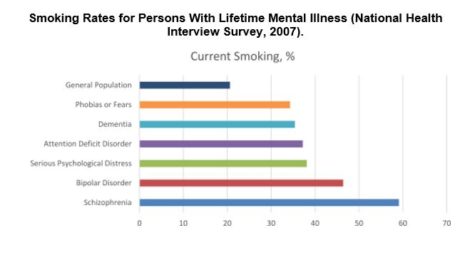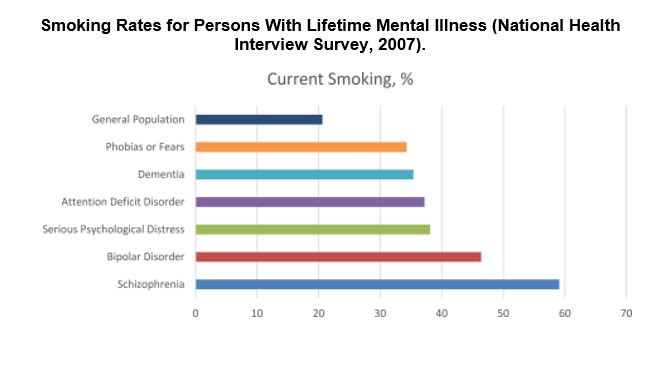A research article first published by the American Cancer Society January 31st 2018 studied which subpopulations continue to smoke. The study reported that smoking among individuals with a serious psychological distress accounted for two-thirds of the difference in life expectancy relative to nonsmokers without a serious psychiatric disorder.
Abstract
 The continuing high prevalence of cigarette smoking among specific subpopulations, many of them vulnerable, is one of the most pressing challenges facing the tobacco control community. These populations include individuals in lower education and/or socioeconomic groups; from certain racial/ethnic groups; in the lesbian, gay, bisexual, and transgender community; with mental illness; and in the military, particularly among those in the lowest pay grades. Although traditional tobacco control measures are having positive health effects for most groups, the effects are not sufficient for others. More attention to and support for promising novel interventions, in addition to new attempts at reaching these populations through conventional interventions that have proven to be effective, are crucial going forward to find new ways to address these disparities.
The continuing high prevalence of cigarette smoking among specific subpopulations, many of them vulnerable, is one of the most pressing challenges facing the tobacco control community. These populations include individuals in lower education and/or socioeconomic groups; from certain racial/ethnic groups; in the lesbian, gay, bisexual, and transgender community; with mental illness; and in the military, particularly among those in the lowest pay grades. Although traditional tobacco control measures are having positive health effects for most groups, the effects are not sufficient for others. More attention to and support for promising novel interventions, in addition to new attempts at reaching these populations through conventional interventions that have proven to be effective, are crucial going forward to find new ways to address these disparities.
The report specifically studies people with mental illness, among other subpopulations:
Mental Illness
The burden from smoking has been particularly high on individuals struggling with mental illness. Tam et al linked NHIS data from 1997 through 2009 to the 2011 National Death Index to construct life tables that enabled the estimation of hazard ratios for smoking status and serious psychological distress. They reported that smoking among individuals with a serious psychological distress accounted for two-thirds of the difference in life expectancy relative to nonsmokers without a serious psychiatric disorder.[21] Evidence suggests that some individuals with mental illness may have a genetic predisposition toward addiction and/or may self-medicate using nicotine.[22, 23] Figure 5 presents everyday cigarette smoking prevalence among people with a past-year serious mental illness versus those without a past-year mental illness. There is a stark gap between the 5% of the population with a serious recent mental illness versus those without. Past 30-day cigarette smoking prevalence among people with a past-year serious mental illness was more than double those without a past-year mental illness (27.9% versus 12.9%).
There is also significant variation among different mental illnesses, as illustrated in Figure 6.[4-6] For example, nicotine addiction has proven to be particularly challenging for many suffering from psychiatric disorders, such as schizophrenia.[24] Smoking prevalence was highest among those with schizophrenia, at nearly 60%. Individuals with such disorders may also experience additional risk factors, such as the easy availability of tobacco in some treatment centers.[25]
Read the full article at the American Cancer Society’s A Cancer Journal for Clinicians.
